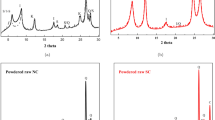Abstract
Silicification is one of the chemical stabilisation methods used in the treatment of collapsible loess soils. The water stability therein is a key parameter in the silicification of grouted loess. Based on slaking tests, permeability measurement, X-ray diffraction spectra, X-ray energy dispersive spectroscopy, and scanning electron microscopy, the water stability mechanism inherent in the CO2-silicification grouted loess was investigated. Samples of original, compacted, and CO2-silicification grouted loess in 30 days curing were tested. To assess the long-term water stability, CO2-silicification grouted loess samples in 13, 19, and 24 years of curing were analysed. The study showed that the CO2-silicification grouted loess had good water erosion resistance, no disintegration, and good water stability over time. The water stability of CO2-silicification grouted loess depended on the strong bond strength of the grains and a low permeability. The complex physicochemical reactions among CO2, water, alkali earth metal salts, clay minerals, and organic matter in loess produced hydrate calcium (and magnesium) silicate gels, which were mainly coated on the surface of the soil skeleton grains and original cements. A few filled in the trellis pores. The gels coated on the soil skeleton limit the hydrophilicity of clay minerals and organic matter and improve water resistance, and if coated on original cements reinforce bond strength, consequently, the water stability of CO2-silicification grouted loess was improved.















Similar content being viewed by others
References
Arshakuni DE, Golubkov VN (1979) Results of twenty-year monitoring of silication stabilization of Odessa theater foundations. Soil Mech Found Eng 6:325–327
Dijkstra TA, Smalley IJ, Rogers CDF (1995) Particle packing in loess deposits and the problem of structure collapse and hydroconsolidation. Eng Geol 40:49–64
Evstatiev D (1988) Loess improvement methods. Eng Geol 25(2–4):341–366
Jefferson IF, Evstatiev D, Karastanev D, Mavlyanova NG, Smalley IJ (2003) Engineering geology of loess and loess-like deposits: a commentary on the Russian literature. Eng Geol 68:333–351
Kruse GAM, Dijkstra TA, Schokking F (2007) Effects of soil structure on soil behaviour: illustrated with loess, glacially loaded clay and simulated flaser bedding examples. Eng Geol 91:34–45
Li BX, Niu YH, Miao TD (2007) Water sensitivity of Malan loess in Lanzhou. Chin J of Geotech Eng. 29(2):294–298 (in Chinese)
Qian HJ, Luo YS, Wang JT (1985) Collapsed loess foundation. China Architecture and Building Press, Beijing (in Chinese)
Rogers CDF, Dijkstra TA, Smalley IJ (1994) Hydroconsolidation and subsidence of loess: studies from China, Russia, North America and Europe. Eng Geol 37:83–113
Rzanitsyn BA, Sokolovich VE, Ibragimov MN (1969) Experience in chemical grouting of loose carbonate soils with summisoil and carbamide resin. Soil Mech Found Eng 4:257–260
Sheinin VI, Ulyakhin OV, Grachev YA (1989) Probabilistic estimate of the design strength of chemically stabilized loess clayey soil. Soil Mech Found Eng 26(2):49–53
Skempton AW(1953) The colloidal activity of clays. In: Proceedings of the third international conference on soil mechanics and foundation engineering. Zurich, Switzerland, ICOSOMEF, pp 57–61
Sokolovich VE (1965) Silicatization of loess soil. Soil Mech Found Eng 2(1):3–7
Sokolovich VE, Semkin VV (1984) Chemical stabilization of loess soils. Soil Mech Found Eng 4:149–154
Wang SX(2005) Study on mechanism and time effect of silicification loess. PhD thesis, Lanzhou University, Lanzhou. (in Chinese)
Wang SX, Han WF, Chen WW (2006) Microstudy on roadbed loess improvement by impact compaction technology. Rock and Soil Mech. 27(5):939–944 (in Chinese)
Weng XL (2007) Studies on seismic subsidence of loess by centrifugal model tests. Chin J of Geotech Eng. 29(7):1094–1097 (in Chinese)
Xie DY (2001) Exploration of some new tendencies in research of loess soil mechanics. Chin J of Geotech Eng 23(1):1–13 (in Chinese)
Xu ZJ, Lin ZG, Zhang (2007) Loess in China and loesslandslides. Chin J of Rock Mech and Eng 26(7):1297–1312 (in Chinese
Yin YX, Wang SX, Han WF (2008) Study on microstructure of co2-silicification grouted loess. Rock and Soil Mech 29(6):1629–1633 (in Chinese)
Yu QG, SHao SJ, Wang T (2007) A novel comprehensive treatment technology for deep wet-collapsible loess foundations. China Civil Eng J 40(12):77–82 (in Chinese)
Acknowledgments
The work was supported by Gansu province science and technology support program (No. 1011FKCA093) and Project of The National Natural Science Foundation of China (No. 51178290).
Author information
Authors and Affiliations
Corresponding author
Rights and permissions
About this article
Cite this article
Lv, Q., Wang, S., Wang, D. et al. Water stability mechanism of silicification grouted loess. Bull Eng Geol Environ 73, 1025–1035 (2014). https://doi.org/10.1007/s10064-014-0646-0
Received:
Accepted:
Published:
Issue Date:
DOI: https://doi.org/10.1007/s10064-014-0646-0




